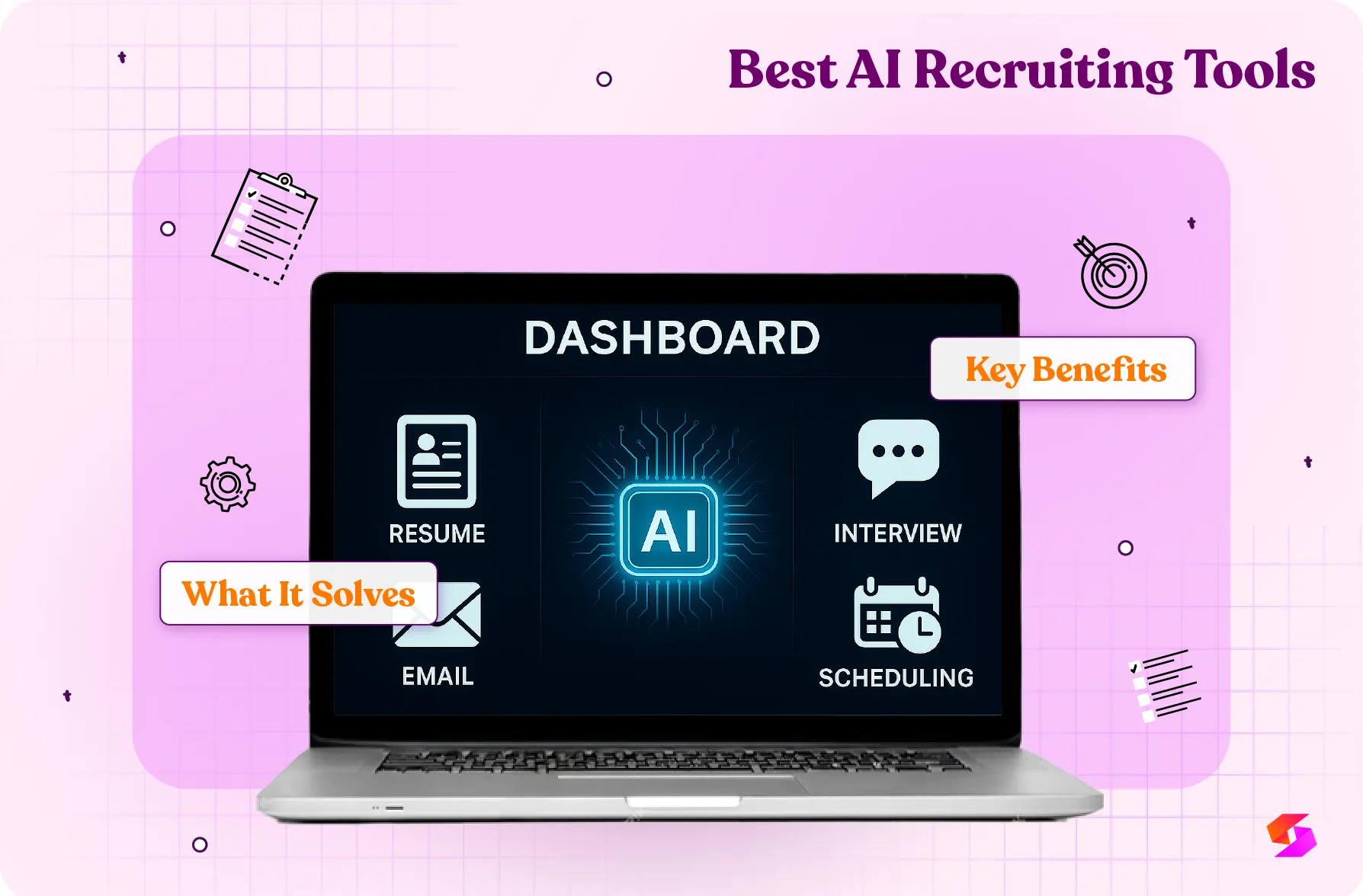- Use a clear policy for social media background checks. Focus only on job-related, publicly available information. This helps ensure fairness and legal compliance.
- Use AI tools like Skima AI to scan candidates’ public profiles. This helps spot potential red flags about behavior and culture fit. Always respect privacy laws during the process.
- Check candidate identities closely to prevent mistakes. Create clear and detailed reports that show key findings for better hiring choices.
- Avoid accessing private content and get candidate consent. Also, follow rules like FCRA and EEOC. This helps keep screening practices ethical and non-discriminatory.
- Use third-party screening services when you can. Record your findings carefully. Give candidates a chance to explain any unclear points for fair evaluations.
A resume only tells part of the story in today’s digital world. Social media background checks provide deeper insights into a candidate’s personality, values, and potential red flags. But with great power comes great responsibility. So, it's important to navigate privacy laws and ethical concerns.
This blog breaks down the step by step process, benefits, legal guidelines, and best practices to help HR professionals conduct social media screening effectively and fairly.
What Is a Social Media Background Check?
A social media background check involves reviewing a candidate's social media profiles and online activity. This covers platforms like Facebook, Twitter, LinkedIn, and Instagram.
On these sites, people share personal and professional details. The goal is to understand a candidate's character, behavior, and how well they align with the company's values and culture.
Unlike traditional background checks that focus on criminal records, employment history, and educational qualifications, social media checks explore a candidate's public online persona.
Traditional checks verify factual information. On the other hand, social media checks aim to assess a candidate's soft skills, values, and potential red flags. These checks provide a broader perspective, allowing organizations to make smarter hiring decisions.
Why HR Professionals Use Social Media Background Checks?
HRs conduct social media background check for several reasons:
- Assessing Cultural Fit: To see if a candidate’s personality aligns with company values and workplace culture.
- Verifying Credentials: To ensure candidates' applications are consistent. You can cross-check the accuracy of the education and work history they disclose on their resumes.
- Identifying Red Flags: To identify potential issues, such as discriminatory remarks, inappropriate content, or evidence of illegal activities.
- Gaining Deeper Insight: To get a deeper insight into the candidate’s personality, skills, and qualifications.
- Saving Time: Social media is one of the cheapest and easiest ways to do a background check.
Legal and Ethical Considerations
The legality of social media screening depends on privacy laws and non-discrimination guidelines. Employers should focus on publicly available information. They must avoid seeking password-protected content or sensitive data. Regulations like the FCRA, EEOC, GDPR, and DPF laws must be followed to ensure compliance.
Guidelines to Ensure Non-Discriminatory Practices
To avoid discrimination, employers should:
- Focus on Job-Related Information: Concentrate on work-related behavior and avoid personal details.
- Apply Consistent Criteria: Use the same standards for evaluating all candidates.
- Be Aware of Biases: Recognize and mitigate personal biases that might influence decisions.
- Protect Privacy: Avoid requesting or accessing private social media content.
How to Conduct a Social Media Background Check?
To ensure accuracy and compliance, a social media background check must be conducted in a systematic way. Here's a 6-step guide:
Step 1. Create a Screening Policy
Develop a clear policy outlining the purpose, scope, and process for social media checks. This policy should specify who will conduct the checks and how the information will be used.
Step 2. Utilize Automated Tools
Use AI-driven tools to search for publicly available information across various social media platforms. These tools scan profiles on sites like Facebook, LinkedIn, and Twitter. They focus only on public content, so they respect privacy laws. For example, some platforms combine data insights with an AI Ad Generator to help HR teams visualize trends and patterns from candidate activity. During screening, you may come across suspicious DMs or links. Use a scam checker like Scamio to scan them for fraud and help HR verify authenticity while protecting candidate privacy.
Step 3. Verify Identity
Confirm that the social media accounts belong to the candidate by using identifiers such as their name, email address, and date of birth. This step is crucial to avoid misattributing content to the wrong person. A verify API can automate this process, ensuring candidate social media profiles are accurately confirmed
Step 4. Review Content
Analyze the content found on the candidate's profiles. Look for specific categories such as potentially unlawful activity, violent behavior, intolerance, and sexually explicit material. Focus on recent posts to ensure relevance.
Step 5. Prepare a Report
Create a detailed report summarizing the findings. This report should include the basis for identity verification, flagged content with explanations, and any relevant personal information that aligns with job-related criteria.
Step 6. Share with Relevant Parties
Provide the report only to those involved in the hiring process, ensuring that it is used solely for employment decisions.
Potential Red Signals to Notice
While reviewing a candidate's social media presence, be mindful of the following red flags:
- Inappropriate Language or Behaviour: Posts with profanity or harsh comments show poor judgment.
- Discriminatory Remarks: Comments or likes that show bias against protected classes (e.g., race, gender) can lead to legal issues.
- Evidence of Illegal Activity: Content depicting illegal activities, like drug use or vandalism, raises concerns about the candidate's judgment and trustworthiness.
- Unprofessional Conduct: Sharing explicit material or having unprofessional discussions can harm a candidate’s suitability for the workplace.
- Confidentiality Breaches: Revealing sensitive information about past employers or clients shows a lack of respect for privacy and confidentiality agreements.
These red flags can have significant implications for hiring decisions and workplace culture.
Best Practices for Employers on Social Media Background Check
To ensure ethical and effective social media background checks, employers should follow these best practices:
1. Engage Third-Party Screening Services
External social media screening agencies increase objectivity and compliance, or advanced adverse media screening tools increase They filter out non-job-related content and ensure legal standards are met. In some cases, broader fraud-detection tools such as Sift are also used alongside these checks to help flag general risk signals. This approach minimizes potential biases and legal risks associated with in-house screenings.
2. Prioritize Job-Relevant Information
When you review a candidate's online presence, focus on content that relates to their job skills and possible behavior at work. Avoid personal details that don’t impact job performance, like religious views or political ties. This approach helps make hiring decisions fair and based on relevant criteria.
3. Ensure Legal Compliance
You must understand the Fair Credit Reporting Act (FCRA) and other relevant regulations governing social media screenings. It's important to have precise, written consent from candidates before initiating these checks.
Additionally, if you consider adverse action based on the findings, give the candidate a pre-adverse action notice. Also, provide a copy of the report and a summary of their rights. This process not only ensures legal compliance but also fosters transparency and trust.
4. Develop and Communicate a Clear Social Media Policy
Create a clear social media screening policy. This should cover the scope, purpose, and procedures of the checks. Share this policy with all stakeholders, including hiring managers and candidates.
Being open about what will be reviewed and how the information will be used sets clear expectations and reduces misunderstandings.
5. Maintain Consistency Across All Screenings
Apply the same screening criteria uniformly to all candidates for a given position. This consistency helps prevent claims of discrimination or bias. Keeping a record of the process and criteria used makes hiring decisions more standardized. This approach promotes fairness and integrity in recruitment.
6. Respect Candidate Privacy
Limit your review to publicly available information. Don’t try to access private profiles or ask for personal login details. This can cause legal issues and damage the organization's reputation. Respecting boundaries not only ensures compliance with privacy laws but also demonstrates respect for candidate autonomy.
7. Avoid Quick Judgments
Context matters when judging social media content. A single post or comment may not show a candidate's true character or skills. Think about the context and how often troubling content appears.
If you're unsure, let candidates explain or clarify. This method promotes fairness and helps ensure you don't miss out on qualified individuals due to single incidents.
8. Document Findings Objectively
Keep detailed records of any job-related information discovered during the screening process. This documentation is essential, especially if a decision is made based on the findings.
Accurate records provide a basis for your decisions and can be invaluable in addressing any future disputes or claims.
Conclusion - Should You Use Social Media Check?
Social media background checks provide useful insights into candidates' personalities and cultural fit. However, they raise important legal and ethical concerns, such as privacy issues and the risk of discrimination. To address these, you can develop clear policies, obtain consent, and target job-specific information.
To further enhance your hiring process, consider utilizing the Skima AI Talent Intelligence Platform. This AI-driven platform automates candidate sourcing, screening, and outreach.
Frequently Asked Questions
1. What is social media screening?
Social media screening involves reviewing a candidate's online presence. This process helps employers assess personality, professionalism, and cultural fit. By analyzing posts, comments, and interactions, they can spot potential red flags or positive traits.
2. How do social media background checks work?
Employers or third-party services check public social media profiles. They verify information, assess behavior, and find possible concerns. These checks focus on job-related content and follow legal and ethical guidelines.
3. Can background checks see private social media?
No, background checks cannot access private social media accounts. Employers can only look at public information. They must follow privacy laws to prevent unauthorized access and avoid unfair hiring practices.




